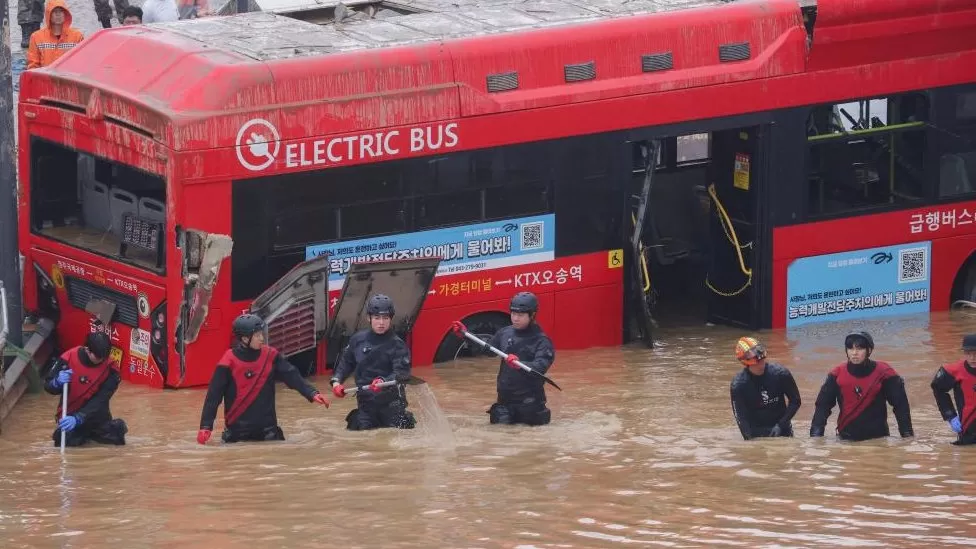In recent days, South Korea has been ravaged by heavy rainfall, leading to devastating floods, landslides, and power outages across the country. One of the most alarming incidents occurred near the city of Cheongiu, where a flooded tunnel trapped numerous cars and their occupants. This article explores the rescue efforts in progress to reach those affected by the flooding and provides an overview of the widespread impact of the torrential rain.
The Flooding and Trapped Cars
Following days of incessant rain, floodwater rapidly inundated a tunnel near Cheongiu, leaving passengers and drivers trapped in their vehicles. The sheer force and speed of the flooding made it impossible for those inside the tunnel to escape. Reports indicate that at least 35 people have lost their lives due to the flooding, landslides, and subsequent power cuts that have affected the entire country.
Recovery Efforts and Tragic Loss
Rescuers have been working tirelessly to reach the trapped cars and rescue those stranded inside. As of now, nine bodies have been recovered from the flooded tunnel, while nine survivors have been successfully rescued. However, the exact number of individuals still trapped remains uncertain. It is believed that 15 vehicles are submerged in the 685-meter long tunnel located in Osong.
READ MORE:
Google Bard: Expanding Horizons with Exciting New Features
Extensive Damage in North Gyeongsang Region
The majority of the fatalities resulting from the flooding have occurred in the mountainous North Gyeongsang region. This area has experienced devastating landslides that have swept away entire houses, exacerbating the impact of the torrential rain. Aerial photographs of the affected regions depict a grim scene, with floodwaters and brown mud submerging villages and leaving only the roofs of buildings visible.
Rainfall Statistics and Meteorological Observations
South Korea typically receives between 1,000mm (39.4in) and 1,800mm (70.9in) of rainfall annually, with much of it concentrated during the summer months. However, the recent deluge has been particularly extreme, with approximately 300mm (11.8in) of rain falling across the country in a single day. The Korean Meteorological Association has warned that the weather conditions pose a “grave” danger to the affected areas.
Evacuation Orders and Military Support
To ensure the safety of the population, local governments have issued evacuation orders, resulting in thousands of people being displaced from their homes. Prime Minister Han Duck-soo has requested the assistance of the military in the ongoing rescue efforts. The military’s involvement is expected to bolster the existing rescue operations and provide much-needed aid to those affected by the flooding.
Dam Overflow and Submerged Villages
The Goesan Dam, located in North Chungcheong, began to overflow, prompting the evacuation of approximately 6,400 residents in the early hours of Saturday morning. The rising water levels submerged nearby low-lying villages and their connecting roads, trapping some residents within their homes. The situation remains critical as the floodwaters show no signs of receding, requiring immediate attention and support.
Train Derailment and Suspension of Services
In North Chungcheong, a landslide caused a train to derail. Fortunately, there were no passengers on board at the time, but one engineer sustained injuries. As a precautionary measure, Korail, the national rail operator, has suspended all slow trains and some bullet trains. The disruption caused by the flooding and landslides has further complicated the transportation system and posed challenges for commuters and rescue operations.
Regional and International Flooding Patterns
South Korea is not alone in facing the devastating impact of intense rainfall and flooding. Several countries across Asia, including India, China, and Japan, have experienced similar disasters in recent weeks. While various factors contribute to flooding, scientists have linked the increased likelihood of extreme rainfall to climate change. A warming atmosphere can hold more moisture, resulting in heavier rainfall over shorter periods and smaller regions.
Climate Change’s Influence on Extreme Rainfall
The influence of climate change on extreme weather events cannot be ignored. As global temperatures rise, the atmosphere’s capacity to retain moisture increases, intensifying rainfall and the subsequent risks of flooding and landslides. The recent torrential rain in South Korea serves as a stark reminder of the urgent need to address climate change and its far-reaching consequences.

